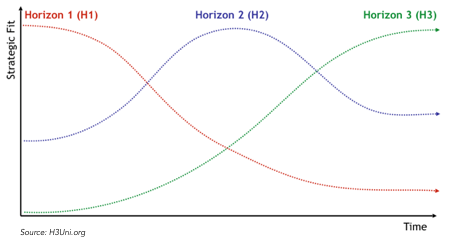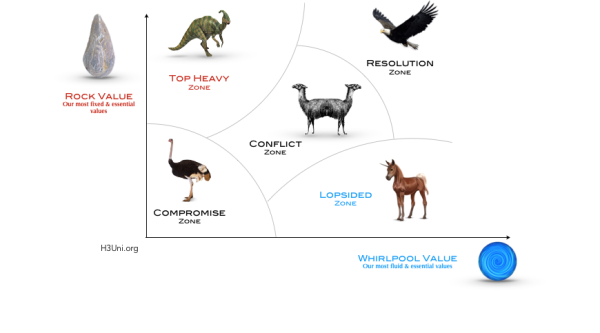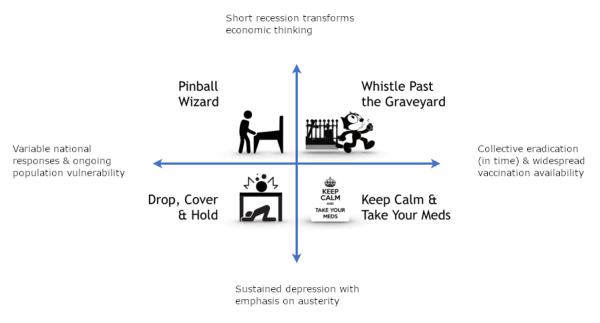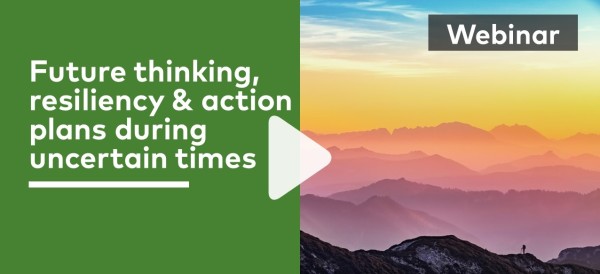‘Future thinking, resiliency & action plans during uncertain times’ was recorded live in March as part of thinkstep-anz’s ‘Straight from the horse’s mouth’ webinar series (watch recording). Our colleague Phil Tate, a trained Regenerative Futurist, introduces future thinking with strategic foresight tools such as the Three-Horizons framework to build resiliency in uncertain times.
Adaptation, resiliency and planning will help organisations to not only survive but thrive in the aftermath of unprecedented scenarios. Strategic foresight is key to this process with tools that are designed to get organisations thinking about the relationship between today and potential tomorrows.
Three Horizons: The realist, the opportunist and the idealist
Three Horizons is a strategic foresight tool that encourages creative thinking about the future. The ‘horizons’ in question represent three lenses of looking at the world and explores how they interact or connect over time. The first ‘horizon’ (H1) is the realm of the realist – based on a managerial outlook that focuses on today’s challenges. Having considered H1, the tool turns attention to the third horizon (H3) that represents the idealistic or visionary view of the future. Finally, the process concludes with an exploration of the entrepreneurial space (H2) led by the opportunistic view and the initiatives that may lead the organisation through from H1 to H3.

Three Horizons is a straightforward tool that draws out multiple perspectives to define collaborative approaches that teams can adopt to achieve their desired future. Bill Sharpe, one of the tool’s creators notes: "it draws attention to the three horizons always existing in the present moment, and that we have evidence about the future in how people (including ourselves) are behaving now".
Dilemma Resolution: Reconciling polar opposites
Dilemma Resolution is an ideal tool to have in your arsenal when you need to reconcile two vital, yet seemingly incompatible values. These values can be represented as polar opposites of each other with a ‘rock value’ representing the most fixed and a ‘whirlpool value’ representing the most fluid.

The Dilemma Resolution tool recognises that both value groups are equally necessary for success. To neglect one in favour of the other is unacceptable and often leads to the uncomfortable worlds of compromise or conflict. The tool aims to challenge this ‘either/or’ mindset and frame a ‘both/and’ conversation that generates solutions that honours both sets of values. A challenging task, which in reality oscillates as a ‘dilemma dance’ between the two, but a valuable capability when faced with seemingly intractable choices.
Assumptions: The map in our heads

Source: TheAndrasBarta, Pixabay
Assumptions define the mental maps that implicitly guide our future actions. Yet, if these assumptions turn out to be wrong, our subsequent actions will be compromised.
Surfacing and examining both our individual and collective assumptions is, therefore, a vital step towards building flexible plans, and relatively easy to do. Organisations can highlight their critical assumptions and, by defining the opposite, consider evidence that may suggest a counter assumption. Exploring the alternatives enables the team to think more creatively about future possibilities and adjust their plans accordingly.
Implications Wheels: Changes and consequences
A robust action plan considers the broader consequences of any new change or development. An Implications Wheel exercise enables the effects of a particular action or event to be pro-actively explored. It helps teams to collectively visualise the direct and indirect consequences of change and the complex interrelationships between them – a great way to expand your team's thinking beyond the obvious and anticipate challenges and opportunities.
Scenarios: A story about the future
There are a variety of possible futures and Scenarios help organisations prepare for a range of eventualities. Basic scenarios (or future stories) can be developed with relatively few resources to support strategic thinking. Creating a basic scenario narrative from critical assumptions and their alternative is perhaps the easiest way for pressured organisations to start exploring their futures.

For example, basic COVID-19 scenarios can be built by taking an axis of economic assumptions and juxtaposing this against one that looks at the effectiveness of national responses to contain the spread. What emerges is four rooms of the future which, while unlikely to unfold as described, highlight key questions that organisations can consider within their plans. Each generated scenario provides insight into the potential next chapter in an unpredictable story to effectively prepare your organisation for what may come next.
Expand your thinking
Unleash your creative thinking with Strategic Foresight and utilise the right tools for your situation to map the way forward to a resilient future. For in-depth frameworks to plan for resilient futures, utilise Three Horizons to bridge the gap between current challenges and future aspirations, and Dilemma Resolution to reach for creative solutions to seemingly irreconcilable values. If you are after a simpler starting point, prepare plans for uncertain times with Assumptions, consider broader consequences with Implications Wheels and allow Scenarios to assess potential actions for a range of possible scenarios to align resiliency plans with your goals.
Moving forward
thinkstep-anz offers specialised services to address the challenges of today's operating environment with a regenerative approach. Find out more about our strategic foresight tools, or contact us to start a conversation.
By Phil Tate, Regenerative Futurist at thinkstep-anz
About Phil
As a trained futurist and regenerative practitioner, Phil helps thinkstep-anz's clients explore their futures by assessing critical drivers of change and how these may combine to drive different outcomes. He assists organisations to anticipate future business sustainability needs and how they may develop further to become regenerative. Read more
April 2020
